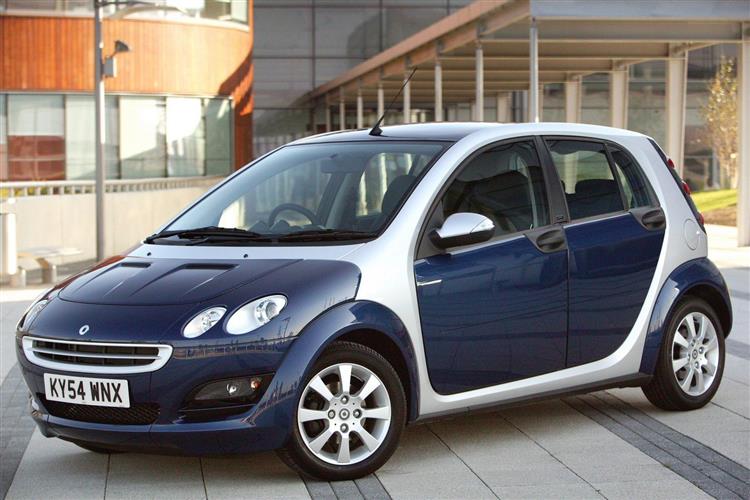FOUR TO THE FLOOR (some text hidden) --NONE--
BY ANDY ENRIGHT
Introductionword count: 104
It came as a shock to many to find a smart that was not only affordable but also a resolutely practical proposition. Until the launch of the forfour, smart had been a rather boutique brand, offering desirable and stylish but rather expensive little cars. The forfour was the company's first toe in mainstream waters and proved instantly popular. Many customers, bored with the likes of the Vauxhall Corsa, the Ford Fiesta or the Peugeot 206, instead went for something with a little more personality and plumped for a forfour instead. Used examples are now emerging and clever buyers can snap up the odd bargain.
Modelsword count: 17
Models Covered: (five-door supermini 1.1, 1.3, 1.5, 1.5T petrol, 1.5 turbodiesel 68, 95bhp [purestyle, coolstyle, passion, BRABUS])
Historyword count: 330
It's odd how a product borne from financial expediency can prove so warmly received. While other examples - say Porsche with the Cayenne - get accused of prostituting brand values in the chase for greenbacks, smart's dabble with the mass market, the forfour, has been an instant hit. What's more, it appears to have had no negative effects whatsoever on the company's brand equity. As a brand, smart have sailed through stormy waters and a financial restructuring statement issued in 2004 saw the company cancel plans for a four-wheel drive model and also axe the pricy roadster and roadster-coupe models. Instead an increased focus is being placed on the cash cows, the dinky fortwo and the forfour we look at here. The reason why MCC needed the Forfour so badly is revealed in their profit and loss accounts. The existing models weren't selling anything like enough and with the sunk costs that had been ploughed into the Smartville plant, it was soon apparent that whichever way you juggled the numbers, the company needed a volume-selling car in order to remain a viable concern. MCC's owners, DaimlerChrysler, were running out of patience and cast about for a partner who could make this happen at minimal cost and came up with Mitsubishi. Sharing 60 per cent of its structure with the Japanese company's Colt supermini, the forfour is cost effective and appealing. Initial production issues were soon ironed out and the forfour range, launched in September 2004, was initially available with 1.1, 1.3 and 1.5-litre petrol engines. Two versions of the 1.5-litre dCi diesel engine were subsequently launched, powered by 68 and 95bhp versions of this fuel efficient unit. A turbocharged BRABUS version of the 1.5-litre emerged as the forfour range topper in May 2005 and coolstyle and purestyle value models appeared in July of that year. The last forfour models were sold by the middle of 2007 as struggling Smart reverted to what it did best with a one citycar line-up.
What You Getword count: 374
Despite its genetic similarity to the Mitsubishi Colt, the forfour nevertheless looks like a smart. The foursquare stance, the bulging wheelarches, beady front lamps and neatly stacked tail light clusters are all familiar design cues but closer inspection reveals a far more conventional car than the smarts we're used to. Much of the personality that makes up a smart car as we know it has been in effect grafted onto the far more prosaic Colt. Put the two side by side and you'd spot the same basic proportions but otherwise MCC have done well with the styling. The exposed frame is painted silver and there are the usual plastic exterior panels. The interior features four seats and plenty of headroom with a sliding rear bench fitted as standard so that you can choose between optimising passenger legroom or luggage space. The bench slides up to 150mm fore and aft and tilts backwards, folds in half or tumbles out of the way. smart even offer what they dub a 'lounge concept', an option where the front seats fold and allow you to stretch out in the back. A three person bench is also offered but by far the best setup is as a four seater with adequate shoulder space. The dashboard isn't what you'd expect, offering a far more conventional basic layout with a centre console, but MCC have livened it up with some jolly colours and auxiliary instrument binnacles so that existing smart owners will find it acceptable. Six airbags, anti lock brakes and electronic stability control are offered and MCC designed the car confident of a strong four-star Euro-NCAP crash test showing. Look closely and you'll find that what looks like a typical smart TRIDION safety cell is in fact a series of conventional painted panels with plastic cladding fleshing out the look. The panel fit on early models wasn't that great (particularly around the doors) but smart say this has since been tightened up. There will be those who see the plastic cladding as a superficial styling extravagance. Others will feel that this car represents a great balance between funky urban style and all-round practicality. We're in the latter camp, preferring this car over its Mitsubishi cousin any day of the week.
To see the full road test text contact us on 0330 0020 227
Pictures (high res disabled)

Scoring (subset of scores)
Category: Small Runabouts
| Performance | |
| Handling | |
| Comfort | |
| Space | |
| Styling, Build, Value, Equipment, Depreciation, Handling, Insurance and Total scores are available with our full data feed. | |



